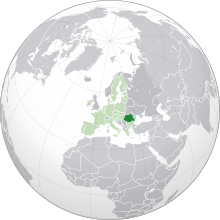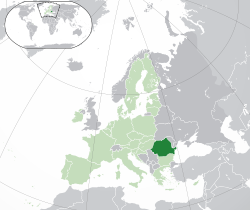
Back Румыниа Abkhazian Rumania ACE Румание ADY Roemenië Afrikaans Rumänien ALS ሮማንያ Amharic Romania AMI Rumanía AN Rumǣnia ANG Romania ANN
Romania România (Romanian) | |
|---|---|
| Anthem: "Deşteaptă-te, române!" ("Awaken thee, Romanian!") | |
Location of Romania (dark green) – on the European continent (green & dark grey) | |
| Capital and largest city | Bucharest 44°25′N 26°06′E / 44.417°N 26.100°E |
| Official languages | Romanian |
| Recognised minority languages[1] | |
| Ethnic groups (2011)[2] |
|
| Religion (2011)[3] |
|
| Demonym(s) | Romanian |
| Government | Unitary semi-presidential republic |
| Klaus Iohannis | |
| Marcel Ciolacu | |
| Legislature | Parliament |
| Senate | |
| Chamber of Deputies | |
| Establishment history | |
| 24 January 1859 | |
| 9 May 1877/1878 | |
| 1918 / 1920 | |
| 30 December 1947 | |
| 27 December 1989[4][5][6] | |
| 6 December 2024 | |
| Area | |
• Total | 238,397 km2 (92,046 sq mi) (81st) |
• Water (%) | 3 |
| Population | |
• 1 January 2021 estimate | 19,186,201[7][8] (61st) |
• 2011 census | 20,121,641[2] |
• Density | 80.4/km2 (208.2/sq mi) (136th) |
| GDP (PPP) | 2022 estimate |
• Total | |
• Per capita | |
| GDP (nominal) | 2022 estimate |
• Total | |
• Per capita | |
| Gini (2020) | medium |
| HDI (2019) | very high · 49th |
| Currency | Romanian leu (RON) |
| Time zone | UTC+2 (EET) |
• Summer (DST) | UTC+3 (EEST) |
| Date format | dd.mm.yyyy (AD) |
| Driving side | right |
| Calling code | +40 |
| ISO 3166 code | RO |
| Internet TLD | .roa |
| |
Romania (old spelling: Rumania, Roumania; Romanian: România, IPA: [ro.mɨˈni.a]) is a country in Eastern and Southeastern Europe.[12] It is north of the Balkan Peninsula, on the Lower Danube River. Western Romania is circled by the Carpathian Mountains. Romania also has a border on the Black Sea.[13] Most of the Danube Delta is found inside Romania. Romania shares borders with Hungary and Serbia to the west, Ukraine to the far northeast, the Republic of Moldova to the near northeast, and Bulgaria to the south.
Romania is a semi-presidential unitary state. It was created when Moldavia and Wallachia joined in 1859. It was given its independence in the Treaty of Berlin of 1878. At the end of World War II, some of its land (close by what is now known as Moldova) was occupied by the USSR. After the Iron Curtain fell in 1989 Romania was liberated from the communist regime. During the 2000s, Romania made changes to the country, such as reform the democratic system, human rights acts, freedom of speech acts, economy and law. That let Romania join the European Union on January 1, 2007.
Romania has the 9th biggest area of land and the 7th biggest population (with 19 million people[3]) of the European Union member states. The capital and biggest city in Romania is Bucharest (Romanian: București ![]() /bu.kuˈreʃtʲ/ (help·info)), with a population of 1.6 million. One of the cities in Transylvania, Sibiu, was named a European Capital of Culture in 2007[14] and a city in Banat, Timișoara, held the same title in 2023.[15] Romania joined NATO on March 29, 2004.
/bu.kuˈreʃtʲ/ (help·info)), with a population of 1.6 million. One of the cities in Transylvania, Sibiu, was named a European Capital of Culture in 2007[14] and a city in Banat, Timișoara, held the same title in 2023.[15] Romania joined NATO on March 29, 2004.
- ↑ "Reservations and Declarations for Treaty No.148 – European Charter for Regional or Minority Languages". Council of Europe. Archived from the original on 8 December 2015. Retrieved 3 December 2015.
- ↑ 2.0 2.1 "Romanian 2011 census (final results)" (PDF) (in Romanian). INSSE. Archived (PDF) from the original on 17 July 2013. Retrieved 28 August 2012.
- ↑ 3.0 3.1 Cite error: The named reference
census_2011_relwas used but no text was provided for refs named (see the help page). - ↑ Elgie, Robert (28 November 2017). Political Leadership: A Pragmatic Institutionalist Approach. Springer. ISBN 9781137346223 – via Google Books.
- ↑ Romania Directory. Editura Cronos. 1 April 1990. ISBN 9789739000000 – via Google Books.
- ↑ "DECRET-LEGE 2 27/12/1989 - Portal Legislativ". legislatie.just.ro.
- ↑ "Populația rezidentă la 1 Ianuarie 2021" [The usually resident population on 1 January 2021] (PDF). Insse.ro (in Romanian). National Institute of Statistics. Retrieved 30 August 2021.
- ↑ "Populaţia rezidentă pe sexe şi vârste, la 1 Ianuarie 2021". Insse.ro (in Romanian). National Institute of Statistics. Retrieved 30 August 2021.
- ↑ 9.0 9.1 9.2 9.3 "World Economic Outlook Database, October 2021 Edition". IMF.org. International Monetary Fund. October 2021.
- ↑ "Gini coefficient of equivalised disposable income – EU-SILC survey". ec.europa.eu. Eurostat. Retrieved 9 August 2021.
- ↑ "2020 Human Development Report" (PDF). United Nations Development Programme. 2020. Retrieved 15 December 2020.
- ↑ "Europe :: Romania - The World Factbook - Central Intelligence Agency". cia.gov. 2007-06-12. Archived from the original on 2020-05-15. Retrieved 2022-12-18.
- ↑ "North Atlantic Treaty Organization (NATO), Official Raport".
- ↑ "Report on the Nominations from Luxembourg and Romania for the European Capital of Culture 2007". The Selection Panel for the European Capital of Culture (ECOC) 2007. 2004-04-05. Retrieved 2008-01-20.
- ↑ "Three new Capitals of Culture for 2023 | Culture and Creativity". culture.ec.europa.eu. Retrieved 2024-10-28.



